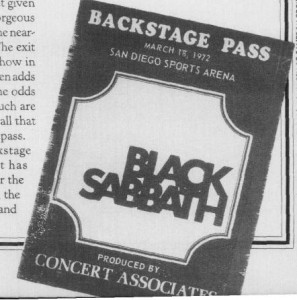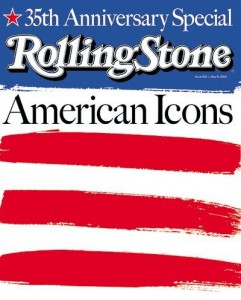Rolling Stone #922: The Backstage Pass
It doesn’t necessarily mean you’re with the band
My first pass was supposed to be at the artists’ gate at the San Diego Sports Arena. The concert featured Yes and Black Sabbath, and I was stranded outside with a tape recorder for many hours, waiting for a road manager to appear with my name and then escort me back to interview the opening band, Wild Turkey. The backstage gate was guarded by an angry, scrawny man in a yellow-checked jacket, who took great delight in telling me that my name was not on the list, never would be, and I was to “go to the top of the ramp with the other girls.” Not that I will remember that menacing guard or his name for the rest of my life (Scotty!), or even the name of the kind concert promoter who eventually took pity on me (thank you, Larry), but I did re-create a version of this scene in the movie Almost Famous to help exorcise the lingering pain. And it was Larry who knew the power and the iconography of the backstage pass when he finally pulled a stack from his pocket, withdrew one and handed it to me with great aplomb, bestowing a key to the castle with simple advice. “Put it in plain view,” he said, “and look like you belong.”
There are unspoken traditions that accompany the hallowed backstage pass. First, though you are always advised to place it prominently on your person, never place it too prominently. There must be a careless take-it-or-leave-it air to the location of your sticky-pass. Never place it in any obvious or prideful position, and always avoid any place a conventioneer might display a name tag. This garish display is reserved for the girlfriends of DJs or the parents of the artist. Best location: upper-right thigh, where a jacket might partially conceal it. This allows you to nonchalantly reveal the pass to any curious security guard and hide it from envious fans in an audience, who sometimes rip and run. Larry’s prophetic words still apply. “Look like you belong” means, essentially, never expose your thrill of being in the rarified world of backstage life. Assume a pleasant, though ho-hum, demeanor as you step over cables, stroll casually past video cameras filming for MTV or bump into Brad and Jennifer. Which brings us to another unspoken backstage tradition. And this is important. Aggressively avoid looking at the actual stars of the evening. A casual peripheral glance is fine, but given the choice of staring directly at a gorgeous Gwen Stefani in full stage attire or the nearby exit sign, there is no contest. The exit sign wins. And the interest you show in any object or person other than Gwen adds to your mystique, and increases the odds that Gwen might speak to you. Such are the complex dictums that govern all that flows from the coveted backstage pass.

Cameron’s First Backstage Pass
The original sticky-style backstage pass lives on, of course, but it has spawned many siblings. The bigger the tour and the larger the road crew, the more ornate the selection of styles and levels of access. A Paul McCartney or U2 tour will employ lanyards, clip-ons and various colors of hospital-style wristbands, sometimes featuring special artwork provided by the artists themselves. These boutique passes are designed to vector guests into many different stations of importance. One colored pass might send you into a room full of international journalists, another might introduce you to the artists’ relatives. One more thing to remember: Even if you have been given the ultimate status pass — the all-access pass — you must never, repeat, never, go onstage with the band unless invited by the band members themselves. Many have stumbled on this last step to greatness and found themselves swiftly whisked back to the cheese trays with the international journalists.
There is another, slightly more sordid style of backstage pass. This pass, made famous by the hair bands of the Eighties, is actually a secretly coded sticker given solely to groupies or potential groupies. The wearer may never fully know the special significance of the colorful or cryptic pass they’ve been given by a friendly roadie. But a band member spotting this pass will know exactly what it means — she’s single, she’s probably available, and her date has been vectored to another room with the international journalists.
And if all this gets too confusing, just go discover a brand-new band, playing a small club, before it’s even designed its first sticky-pass. You’ll find no assistants, no bodyguards, no palace-level security. Walk in that unguarded door and tell ’em you love their music. Just remember one thing: Look like you belong.
Courtesy of Rolling Stone #922 – Cameron Crowe – May 15, 2003


